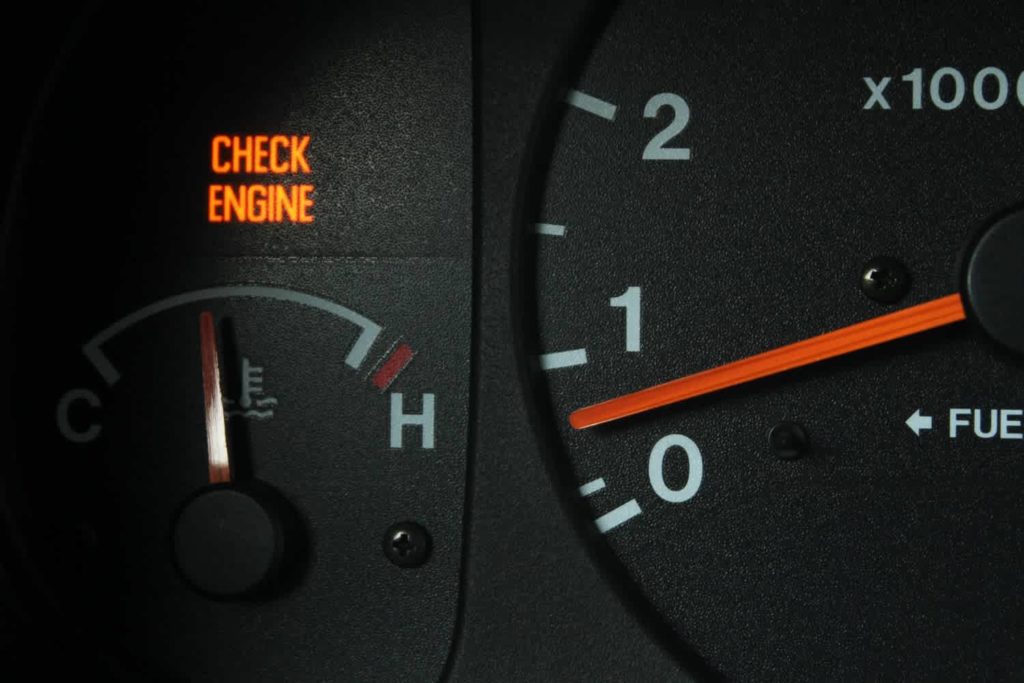Your car has many different sensors, including one or more camshaft position sensors. Although camshaft position sensors are designed to last the life of the vehicle, that doesn’t always happen. Over time, these sensors can degrade to the point that they produce an erratic signal or no signal at all.
If your car experiences a camshaft position sensor failure, you’ll likely notice one or more troubling symptoms that you’ll want to address right away.
What Does a Camshaft Sensor Do?
Before you can understand a camshaft position sensor, you need to know how the engine’s camshaft(s) and crankshaft work. Every internal combustion engine has a crankshaft and one or more camshafts (the number of camshafts depends on the engine’s design).
The camshafts open and close a series of valves that allow air (and fuel, in the case of port injection) into the engine and exhaust gases out.

Meanwhile, the crankshaft is attached to the connecting rods and pistons. When the vehicle is running, the valves allow air to enter the engine’s cylinders and mix with fuel. The mixture is ignited by the spark plugs, creating a series of small explosions. Each explosion forces one of the pistons downward inside the engine.
The movement of the pistons makes the crankshaft turn, creating the rotational force needed to propel your vehicle down the road.
One or more camshaft position sensors measure the speed and position of the camshaft(s). Many late-model vehicles equipped with variable valve timing (VVT) have one camshaft position (CMP) sensor for each of the engine’s camshafts. Each CMP sensor reads a wheel or plate, which is usually located at the end of the corresponding camshaft. On some older vehicles, the CMP sensor might read the rotation of the camshaft-driven distributor instead.
On most vehicles, the engine computer, which is often referred to as the powertrain control module (PCM), uses the data from the CMP sensor(s) when calculating injector pulse and/or ignition timing. If the engine is equipped with VVT, the PCM will also use the CMP signal(s) when calculating valve timing.
Depending on the vehicle, the module may also use the CMP signal(s) to monitor the engine for misfires and calculate other parameters.

The Top 3 Symptoms of a Bad Cam Position Sensor
Do you think you might be dealing with a bad CMP sensor? If your vehicle is exhibiting one or more of the following symptoms, you might be correct.
Note: Because other problems can present the same symptoms as a faulty CMP sensor, you’ll want to perform a thorough diagnosis before condemning the sensor.

Illuminated Check Engine Light
The PCM monitors the integrity of each CMP sensor and its circuit. If the module detects a problem, it turns on the check engine light and stores a corresponding diagnostic trouble code (DTC) in its memory.
Engine Performance Problems
Because the data from the CMP sensor(s) is often used as an input for everything from fuel injector timing to VVT operation, a bad sensor can potentially lead to a variety of engine performance problems. Examples include misfiring, rough running, lack of acceleration, and stalling.
Vehicle Refuses to Start
On some vehicles, the CMP sensor is a primary input for fuel delivery and/or spark control. As such, a faulty CMP sensor can prevent the engine from getting proper fuel or spark (or both), resulting in an engine that cranks but doesn’t start.
How To Check if a Camshaft Position Sensor is Bad?
Because many other issues can mimic a bad CMP sensor, you (or your mechanic) will need to do some troubleshooting to determine whether the sensor is faulty.
Before getting started, however, you’ll want to have the vehicle’s repair information handy. Manuals, such as those from Chilton, are good, but a subscription to a repair database (e.g., ALLDATA or Mitchell 1 DIY) is even better. You can find more information on accessing quality repair information in our article on repair manuals.
Note: The following are general guidelines for educational and entertainment purposes only. Consult your vehicle’s factory information for specific repair instructions and recommended safety procedures.

Step 1: Check for Diagnostic Trouble Codes
A faulty CMP sensor will typically set one or more DTCs on vehicles model year 1996 or newer. The DTC(s) can be retrieved by connecting a scan tool or code reader to the vehicle’s onboard diagnostic port underneath the dashboard.
If there are CMP-related codes stored, that means the PCM has detected a problem with the performance of the sensor or its circuit. Keep in mind, however, that DTCs do not tell you exactly what’s wrong with a vehicle. Codes merely give you an idea of where to begin your diagnostic process.
The root cause of the issue could be anything from a faulty sensor to an engine mechanical problem, so you’ll need to do some additional diagnostic work to know for sure.
Step 2: Perform a Visual Inspection
Next, you can move on to performing a visual inspection. You’ll want to look for issues, such as damaged wires and poor connections. Make sure that the CMP sensor’s electrical connector is clean and tight.
Repair any issues found during the visual inspection, clear the DTCs, and see whether the problem returns.

Step 3: Test the Sensor Directly
Testing a CMP sensor can be tricky. There are two primary types of CMP sensors: magnetic and Hall effect. Magnetic sensors output an alternating current (AC) voltage frequency signal, while Hall Effect sensors create a square wave digital signal. It’s important to know what type of sensor your car has.
You can distinguish between the two types of sensors by noting that magnetic CMP sensors typically have two wires, whereas Hall effect sensors usually have three wires. Consult a repair manual or repair database if you don’t know what type of sensor your car has.
It’s best to test the CMP sensor’s output signal with an oscilloscope. However, most DIYers only have access to a digital multimeter (DMM). You can use a DMM to check a CMP sensor’s output signal, though the results can sometimes be misleading.
Also, in some instances, the vehicle manufacturer will specify resistance values for magnetic CMP sensors. You can check the resistance of a CMP sensor with a DMM turned to the ohms setting, then compare that value to the specifications found in a repair manual or repair database.
The video below demonstrates testing both types of sensors with a DMM:
The video below demonstrates testing a Hall effect CMP sensor with a DMM:
How Much Does It Cost to Replace a Camshaft Sensor?
If you choose to have a professional replace your car’s CMP sensor, you can usually expect to pay somewhere between $100 and $300 to get the job done. Of course, the exact cost will depend on various factors, such as the year, make, and model of your vehicle.
You can save money by replacing the CMP sensor yourself if you have the tools and the know-how. CarParts.com has a wide variety of replacement CMP sensors available for various makes and models.
Camshaft Position Sensor FAQ
What Causes a Camshaft Sensor to Go Bad?
CMP sensors are subject to the harsh operating conditions found in the engine compartment. In most cases, the sensors simply wear out over time. The sensors can also be affected by metal debris (an indicator of bigger problems) circulating through the engine.
Can I Drive With a Bad Camshaft Position Sensor?
It depends on the vehicle and how that PCM uses the CMP sensor in its engine control strategy. If the PCM only relies on the CMP sensor for, say, misfire monitoring, you’ll likely be able to keep driving. On the other hand, if the CMP sensor is the primary input for fuel injection timing, the vehicle may not run once the sensor’s signal is lost.
In any scenario, you’ll want to replace the CMP sensor right away. Failing to do so can eventually damage other parts of the vehicle, such as the catalytic converter.
How Do You Fix a Camshaft Position Sensor?
When a camshaft position sensor fails, it is replaced rather than repaired. The good news is that CMP sensors are generally fairly affordable and easy to replace.
Any information provided on this Website is for informational purposes only and is not intended to replace consultation with a professional mechanic. The accuracy and timeliness of the information may change from the time of publication.






























I have 2015 GMc Terrain. Mechanic says its my transmision that cauing the problem.The problem if I start to acclerate from a standing start my car shudders by the time I hit about forty miles a hour and then the noise goes away and speed and accleration at.higher speeds no problem. No engine light comes on -no problem starting or wih fuel consumption. I had similar problem with.my last car jeep 2012. It was a cam sensor. Not the transmission. I was wondering if this is not the same problem and not transmision?
Hello,
There’s a good chance your mechanic is correct. Problems with the torque converter, valve body, transmission (or all three) can cause a shuddering sensation. However, if you doubt the diagnosis, we recommend getting a second opinion from another shop.
Worst job i ever had, trying to replace a cam shaft sensor and its shaft on a 4.0 ford ranger.